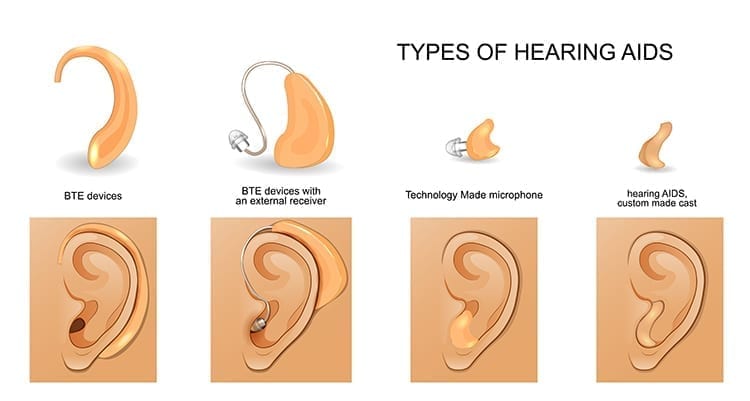Types of Hearing Aids
What Are the Different Types of Hearing Aids?
Hearing aid technology has vastly changed over the past few decades. There are now so many different choices to suit your hearing needs, style and budget. The amount of choices is almost too confusing- that’s why we are here to help! We break down most everything you need to know below.

THE NEWEST HEARING AIDS
The technological revolution has completely changed everything about hearing aids. What used to be a giant amplifier you had to manually hold up to your ear has transformed to small, virtually invisible, natural sounding devices that are more and more like the hearing experience you had before losing your hearing.
Digital hearing aids are the top choice for most patients and are the number one device sold today. The quality of the sound is impeccable and resembles the hearing you used to have, however the hearing device you purchase depends on many factors- and we would love to help guide you through the process.
DIGITAL HEARING AID FEATURES
Digital hearing aids can act on soft sounds in one way and on loud sounds in a completely different fashion. The more advanced the digital chip the more bands that it will possess. Some digital hearing aids have the capability to reduce some environmental noises such as motors running or dishes clanging.
There are so many options available to you! There are four basic technology levels: Economy, Basic, Advanced and Best. Each level offers digital hearing solutions based on your level of hearing loss, lifestyle and budget.
LEARN MORE
CONVENTIONAL (ANALOG) HEARING AIDS
These devices are essentially amplifiers that have manual (as opposed to automatic with digital) volume controls. These hearing aids are best in one type of environment, such as at home, in quiet situations such as having a phone conversation or listening to music. These types of devices are limited in their functions as they are not flexible in meeting individual hearing needs, like digital devices can.
POPULARITY OF WIRELESS HEARING AIDS
Having your hearing back may not mean what you think it means! You don’t have to listen to everything- our team can program your digital hearing aids to help you drown out the noises you don’t want to listen to and hear what you do want to listen to.
Wireless hearing aids are booming because of their convenience. This incredible technology can be paired with a smart device which connects your hearing aid directly to the sound sources you want to hear, such as your tv or computer.
The hearing aids will pick up on those sounds you select and dampen other noises, such as the vacuum or dishwasher running, so you can really focus on the game, or movie, or song!
Finding the Right Type of Hearing Aid
First of all, we understand that you want something totally discreet but that works well for you. All of our patients have this as their main request, and it’s understandable! That’s why we have many options that fit both of those needs.

Behind the Ear (BTE) Hearing Aids
BTE hearing aids are suitable for many types of people, of varying ages and hearing levels. They are made to fit behind the top of your ear and are easily hidden by your hair. Even with short hair, these are small and very discreet.
An ear mold is custom shaped to fit perfectly in the contours of your ear, which makes them very comfortable. They are available in different colour choices and have the ability to be customized and programmed to suit your hearing needs.
In the Ear (ITE) Hearing Aids
ITE hearing aids are completely custom. The entire device is molded to fit your outer ear with a snug, perfect fit, providing excellent amplification for those with mild to severe hearing loss.
These hearing aids are also beneficial in particular to those with disabilities or dexterity challenges as they do not slip or fall out of the ear.
You can have many functions and features with this type of hearing aid and they can come in many colours.
In the Canal (IC) Hearing Aids
These hearing aids are some of the smallest, most discreet and invisible devices available and can be suitable for mild to moderately severe hearing loss. They are completely custom and provide amplification while being fit inside of the ear canal. They are incredibly tiny, just 1-3cm long!
There are a second type of IC aids, called “Completely in the Canal” (CIC). These are even smaller and sit deeper inside of the canal, closer to the eardrum, however they offer less features and may or may not have wireless capabilities.
Receiver in the Ear (RIC) Hearing Aids
Perfect for a very active person, RIC hearing aids can be programmed to suit the needs of hearing losses that are mild to severe. They are discreet, and hidden in the ear or under your hair.
These technological devices are best at allowing you to focus on conversations while in very distracting environments, using a directional microphone technology. It will amplify the target (main) speech signal and dampen any background noises.
RIC devices have many programmable features and functions like telecoil, automatic programming, volume or programming controls and alert signals. It can also come with accessories which activate the bluetooth compatibility. With bluetooth, you can easily connect your RIC hearing aids to your phone, your iPad or even your car.
Extended Wear Hearing Aids
If you’re looking for invisible and practically maintenance free, with the ability to wear your aids 24/7 for months at a time, this type of device is perfect. It provides the invisibility of ITC hearing aids with extended wear technology for the ultimate combination of convenience.
This style of device is suited for those with mild to moderately severe hearing loss, and the proximity of the hearing aids to the eardrum ensures great sound while reducing distortion (like the barrel effect) and background noise.
Special Hearing Aid Features
Lots of hearing aid styles have the ability to be programmed specially with features like noise management, auto adjustments, ear to ear communication, function controls, directional microphones, wireless bluetooth controls, music programs and telecoil.
Functions and features like these help make communication much easier. The telecoil feature is also useful in public facilities with induction loop systems.
As always, consult with our hearing professionals to determine which features are best for you!
Are Assistive Listening Devices the Solution?
A range of assistive listening devices is available to help people with distinctive hearing needs.
HOW DO THEY WORK?
Typically, hearing aid devices use microphone technology to capture sounds and send signals wirelessly over an FM transmission (Frequency Modulation) or other transmission methods. We know…this is sounding a little like you should be breaking out the old transistor radio, and the technology isn’t all that different!
FM transmission systems do use radio signals to transmit sounds. These are great for public spaces.
Infrared transmission systems use light to transmit sound. Unlike other methods, this way signals cannot pass through walls. This is useful in places like schools or movie theaters. Infrared cannot be used outside or in placed with lots of bright lights as it cannot compete with too many light sources.
Having a personal amplification is useful in places where other transmission systems cannot perform. They are also great for low-noise environments such as car travel or watching television. They are about the size of a cell phone, and increase sound levels and reduce background noise for a listener.
